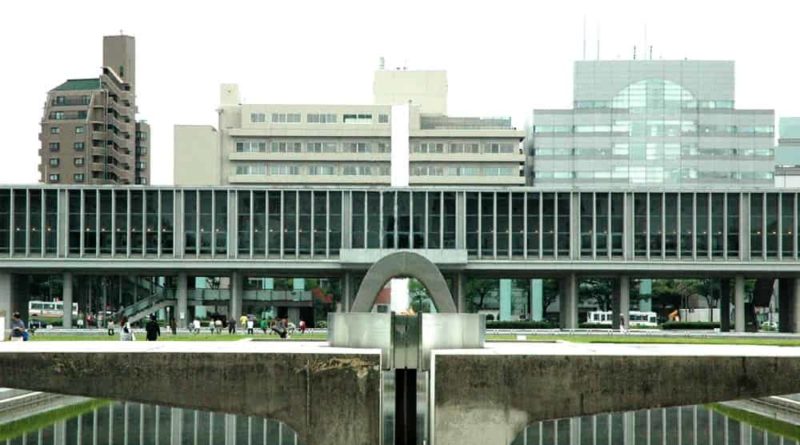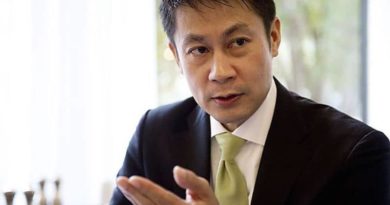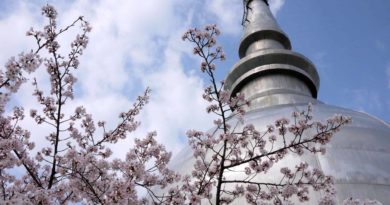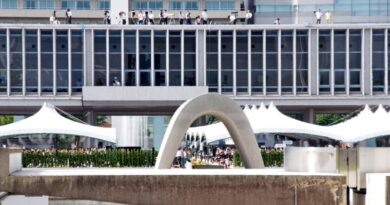Hiroshima Peace Memorial Museum
The Peace Memorial Museum [Hiroshima Heiwa-kinen-shiryou-kan 広島平和記念資料館] is visited by over a million people each year from Japan and around the world.
The museum grew from humble beginnings, as a collection of artifacts pulled from the rubble of the burnt plain by a local geologist who would become its first curator. The Peace Memorial Museum’s modern form dates from 1955 and is an imposing building of concrete and glass. Part of architect Kenzo Tange’s Peace Center design, it is raised above the ground by huge Le Corbusier-inspired piloti and stands at the southern end of Hiroshima’s Peace Memorial Park, alongside Peace boulevard [Heiwa O-dori 平和大通り]. People from all around the world come to learn about the A-bombing of Hiroshima on August 6, 1945 and its aftermath.
The museum has been undergoing extensive renovations since 2014 and the revamped east building reopened on April 26, 2017. Work on the west wing is planned to be completed by the summer of 2018. What follows is a description of the east wing.
The new layout of the museum is more open and should help accommodate the record numbers of visitors it has been receiving in recent years, thanks to a reported “Obama effect” following his May 2016 visit when he delivered his historic speech in front of the museum and the continued rise in overseas tourists.
The infamous mannequins depicting A-bomb victims in the hours after the bombing, the static diorama of the city over which hung a large red sphere representing the blast, and the reconstruction of the A-bomb Dome are gone.
They are replaced by a striking 90 second CGI representation of the bombing seen from above titled “White Panorama” and expansive touch-activated interactive tables which display images and explanations that can used by many people at one time.
The museum still gets quite crowded and a quiet viewing lounge, just off from the main exhibition rooms, where videos of A-bomb survivors retelling their experiences is a welcome addition.
Admission to the permanent exhibition is still a very reasonable ¥200 (audio guides – which mostly narrate what is on the information boards that accompany the exhibits are an additional ¥200. Admission to a first floor exhibit which displays some of the museum’s most well known, and moving, artifacts is free of charge.
Here, some of the tiny origami cranes folded by Sadako Sasaki are also in displayed (parents with small children should be aware that some of the most graphic photographs in the museum are also in this section).
The new gift shop in this free area has a very good selection of Japanese and English literature suitable for a range of ages.
Visitors should also take time to view the newly acquired exhibits room on the basement floor where Peace cranes presented to the museum by President Obama are displayed along with his handwritten message. Admission to the basement floor is also free of charge.
The main main building closed for renovation on the same day as the east building reopened. It is planned that the entire museum will be open to the public once again from summer 2018.
Some overseas visitors feel nervous about how they will be received and avoid engaging with the volunteer guides for this reason. You will find, however, that as with people just about everywhere else in Hiroshima, they are in no way judgmental and are sincerely happy that you are taking the time to find out more about the tragedy. That said, it is perfectly understandable to want to move around the museum at your own pace, processing the exhibits by yourself.
Diving straight back into the bustle of city life after the museum can be something of a shock to the system. I recommend visiting the museum first, followed by some time in the park for contemplation and to provide a psychological buffer. There is a good chance that you will be approached by Japanese kids on school trips who will want to ask you some simple questions in English. Their giggles are infectious and can do a great deal to lift your spirits.
Finally, I strongly suggest that you resist the urge to hole up in your hotel. After the necessary contemplation, get out into the city and eat, drink and, yes, make merry, with its people. It’s only then, I think, that you can get a true and full appreciation of what a special place Hiroshima is.
Opening hours
- 08:30-18:00 pm March-July & September-November
- 08:30-19:00 in August (and until 20:00 on August 5th & 6th)
- 08:30-17:00 (December to February: 8:30-17:00)
- Final admission 30 minutes before closing.
- Closed December 30 & 31.
Entrance fee
- Adults: ¥200
- High School: ¥100
- Junior High School & younger: free
- Audio guides are available for rent in English and Japanese for ¥200
- Non-flash photography is permitted
- Volunteer guides (free of charge) who can take you around the museum and/or the memorial park may be available. Click here for more details.
Address: 1-2 Nakajima-cho, Naka-ku Hiroshima-shi, Hiroshima-ken
Address in Japanese: 広島県広島市中区中島町1−2
Tel: 082-241-4004
URL: http://hpmmuseum.jp/
Email: hpcf@pcf.city.hiroshima.jp





